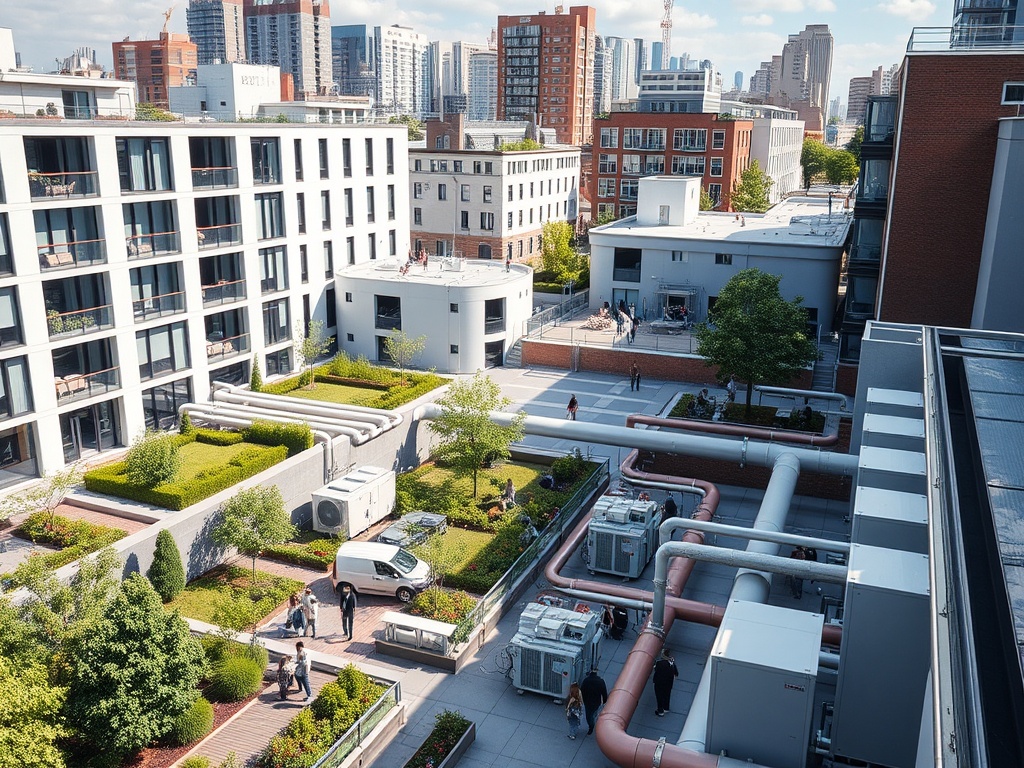Heat Pumps: A Look Towards the Future
Heat pumps are becoming a hot topic in discussions about urban living, particularly in the context of future cities where they may soon become a standard feature. These innovative heating systems are being actively promoted due to their potential to produce significantly lower carbon emissions compared to traditional gas central heating, which is currently the norm in approximately three-quarters of homes in the UK.
However, some homeowners remain hesitant. The initial investment for installing a heat pump can be considerable, and the process often involves disruptive construction work. In contrast, a small yet growing number of residences are utilizing advanced “district heating systems,” which consist of communal heat pumps that service entire streets or blocks of flats. These super heat pump systems are projected to save households hundreds of pounds annually on their energy bills. According to the district heating firm Vital Energi, energy costs could be reduced by as much as 40% compared to installing individual heat pumps in each building.
Furthermore, these systems are even more carbon-efficient, which is crucial for the UK’s net-zero targets. Several of these district heating systems are already operational across various sites in the UK, with government plans in place for an additional seven systems in cities including Leeds, Plymouth, Bristol, Stockport, Sheffield, and two locations in London. By 2050, these systems could account for a fifth of the UK’s total heat demand, as outlined in the previous government’s Net Zero Growth Plan. Instead of relying on gas supply, these super heat pumps utilize a network of pipes that transport hot water directly to homes.
Some of these systems employ water-source heat pumps that draw thermal energy from rivers through an intricate network of submerged pipes. Others utilize ground-source heat pumps, which are installed beneath roads. Customers have the ability to regulate their hot water consumption and the amount of heat supplied to their radiators, which allows for tailored billing based on usage. However, it’s worth noting that any heat pump system generally offers greater efficiency compared to conventional gas boilers, leading to lower energy costs, as explained by Bean Beanland of the Heat Pump Federation.
One of the pioneering district heating schemes in the UK harnesses heat from the River Clyde in Glasgow. This initiative is part of a £250 million regeneration project in a former docklands area known as Queens Quay. Since 2020, the water-source heat pump system has been connected to several new office buildings and public facilities within the development. As of 2024, this system began supplying heat and hot water to two residential blocks. One block is newly constructed, while the other is a complex retrofit of a tenement building dating back to 1919.
Previously, these tenement flats relied on electric storage heaters, which resulted in prohibitively high energy bills, as noted by Jack Devlin of Clydebank Housing Authority, which oversees the properties. With the new heating system, residents typically pay between £60 to £70 a month for heating. In contrast, similar tenement flats that utilize gas-powered heating incur costs of around £140.
Resident Testimonials

Elizabeth Thom is one resident in Glasgow benefiting from the heat energy extracted from the River Clyde. Previously reliant on electric storage heaters, her tenement block is now connected to the district heating network established in the Queens Quay waterfront redevelopment. Through green subsidy programs, Clydebank Housing Association facilitated her building’s connection to this network.
Elizabeth’s monthly bill reflects her consumption of hot water. This winter marks the first with the new heating system, and last month her heating bill amounted to £56. When combined with her electricity expenses, her total monthly costs hover around £100. Previously, her winter electricity bills could reach up to £140 due to the inefficiency of storage heaters. While she is pleased with the warmth provided once the heating is activated, she is cautious about usage due to the ongoing cost-of-living crisis, opting to turn it on for only a couple of hours each evening. “Once you get it on, it is warm. It’d be great if you could put it on for longer and generate the heat constantly,” she explains. “But I’m happy with the system.”
Looking ahead, an even more extensive scheme is under development in central London, which will utilize heat sourced from the River Thames. Notable landmarks including the Houses of Parliament, Westminster Abbey, and the National Gallery have been identified for potential integration into this innovative system.
This ambitious project will involve a network of underground insulated pipes transporting hot water at 85°C across an area spanning from Victoria Station to the Strand, bordered by St James’s Park to the west and the Thames to the east. The initiative is backed by two district heat network companies, Hemiko and Vital Energi, who have formed a collaborative partnership known as the South Westminster Area Network (Swan) Partnership. The plan has garnered support from the Department for Energy Security and Net Zero, as well as Westminster City Council.
The Swan Partnership is currently engaging with prospective customers, although their identities remain confidential at this stage, according to Charlotte Owen, growth director at Hemiko. “We have really strong enthusiasm and will to join the network among lots of different buildings, ranging from the public sector through to big hotels and major banks. We’re still under confidentiality agreements with them, but the network is very much happening.”
Additionally, some residential blocks in the Westminster area may also be eligible to connect to the heat network, particularly if they currently utilize a communal gas boiler serving all flats. “There are a few buildings that have approached us and said: ‘We are a group of tenants that are really motivated by decarbonisation, and we want to join the heat network,’” she added.
A district heat network is also operational in Stithians, a quaint village in Cornwall, which employs ground-source heat pumps. While ground-source pumps can be installed in individual homes, doing so typically necessitates extensive excavation, either through a network of trenches or deep boreholes in gardens.
The decision to implement a district heat network in Stithians was influenced by the fact that the village lacks access to the mains gas supply, resulting in most homes relying on electric storage heaters. “If we’re taking people off storage heating, we tend to see a 40 to 50 per cent reduction in bills,” stated Wouter Thijssen, director of Kensa, the company responsible for the Stithians district heat network.
“The challenge has always been that for an air-source pump, you put a box outside your house, and for a ground-source pump, you need to drill a hole, which incurs higher costs. But when we start linking all of these holes together and have one utility company come to your street to drill all of them and then charge residents a monthly fee, that’s when we see ground-source systems being adopted on a larger scale,” Thijssen concluded.




